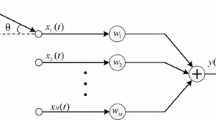Abstract
Aiming at the inherently problems that interpolated transformation technique can not work effectively over a large transformation area, and the sidelobe level is high during beamforming. In this paper, we propose a new algorithm by designing the weight of interpolated array to jointly optimize sidelobe level and transforming error. The key feature of this algorithm is that in the case of minimizing the error of output signal power which is caused by transforming error, the sum of the sidelobe power is constrained to minimum by the angle weighting function. Numerical simulations prove the validity of this new algorithm. In comparing with the existing algorithms, this algorithm can achieve low sidelobe beamforming in a large transformation area, and it overcomes high current taper, mainlobe expansion, and inability to use the window function to suppress sidelobe in interpolated array. Besides, it has good reception and suppression effects for the spatial wave signals from the mainlobe and the sidelobe, respectively.








Similar content being viewed by others
References
Lv X, Gao B, Liu R (2000) A study on the geometry of smart antenna with low side-lobe. J Microw 16(5):594–598
Wang Y, Ding Q, Li R (2006) Adaptive array processing. Tsinghua University Press, Beijing, p 28
Dolph CL (1946) A current distribution for broadside arrays which optimize the relationship between beamwidth and sidelobe level. In: Proceeding of the I.R.E. and waves and electrons, pp 335–348
Nuttall AH (1981) Some windows with very good sidelobe behavior. IEEE Trans Acoust Speech Signal Process 29(1):84–91
Safaai-Jazi A, Stutzman WL (2016) A new low-sidelobe pattern synthesis technique for equally spaced linear arrays. IEEE Trans Antennas Propag 64(4):1317–1324
Liang S, Feng T, Sun G (2017) Sidelobe-level suppression for linear and circular antenna arrays via the cuckoo search–chicken swarm optimisation algorithm. IET Microw Antenna Propag 11(2):209–218
Rntna Kumari UV, Raju GSN, Prasad GMV (2016) Generation of low sidelobe beams using Taylor’s method and genetic algorithm. In: 2016 International conference on electromagnetic interference and compatibility (INCEMIC), pp 1–5
Han L, Liu Y, Sun G et al (2017) Beam pattern synthesis based on improved biogeography-based optimization for reducing sidelobe level. Comput Electr Eng 60:161–171
Khalid A, IVIH Shah (2017) Pattern synthesis of conformal antenna array to achieve optimized amplitude weights for null steering and PSLL reduction. In: Proceedings of 2017 14th International Bhurban conference on applied sciences and technology (IBCAST) Islamabad, Pakistan, 10th–14th January, 2017
Al-Husseini M, Ghaziri H et al (2017)Rectangular and circular arrays with independently controlled beamwidth and sidelobe level. In: 2017 IEEE international symposium on antennas and propagation and USNC/URSI national radio science meeting, pp 1395–1396
Friedlander B (1990) Direction finding using an interpolated array. IEEE Int Conf Acoust Speech Signal Process 5:2951–2954
Lee TS, Lin TT (1997) Adaptive beamforming with interpolated arrays for multiple coherent interferers. Signal Process 57(2):177–194
Zhang Y, Zou Z, Lv Z et al (2007) Beamforming of coherent signals based on uniform circular array. J Electron Sci Technol 36(1):20–23
Yang P, Yang F, Nie ZP et al (2010) Robust adaptive beamformer using interpolated arrays. Progress Electromagn Res B 23:215–228
Li W, Li Y et al (2011) Adaptive beamforming method for arc length based virtual antenna array. In: IEEE conference publications, pp 135–139
Friedlander B, Weissa J (1992) Direction finding using spatial smoothing with interpolated arrays. IEEE Trans Aerosp Electron Syst 28(2):574–587
Pesavento M, Gershman AB, Luo ZQ (2002) Robust array interpolation using second-order cone programming. Signal Process Lett 9(2):8–11
Hyberg P, Jansson M, Ottersten B (2002) Array mapping: optimal transformation matrix design. IEEE Int Conf Acoust Speech Signal Process 3:2905–2908
Hyberg P, Jansson M, Ottersten B (2004) Array interpolation and bias reduction. IEEE Trans Signal Process 52(10):2711–2720
Dogan MC, Mendel JM (1995) Applicaion of cumulants to array processing-part I: aperture extension and array calibration. IEEE Trans Signal Process 43(5):1200–1216
Peng H (2006) Study on beamofrming algorithm of array with virtual elements. Northwestern Polytechnical University, China, pp 31–38
Kraus JD, Marhefka RJ (2005) Antennas: for all applications. Beijing Electronic Industry Press, Beijing
Acknowledgements
This work was supported by the (National Natural Science Foundation of China) under Grant (Nos. 61601326, 61371108).
Author information
Authors and Affiliations
Corresponding author
Rights and permissions
About this article
Cite this article
Ma, S., Pan, F. & Meng, X. Beamforming Based on Joint Optimization for Array Interpolation. J. Electr. Eng. Technol. 14, 479–485 (2019). https://doi.org/10.1007/s42835-018-00025-5
Received:
Revised:
Accepted:
Published:
Issue Date:
DOI: https://doi.org/10.1007/s42835-018-00025-5




